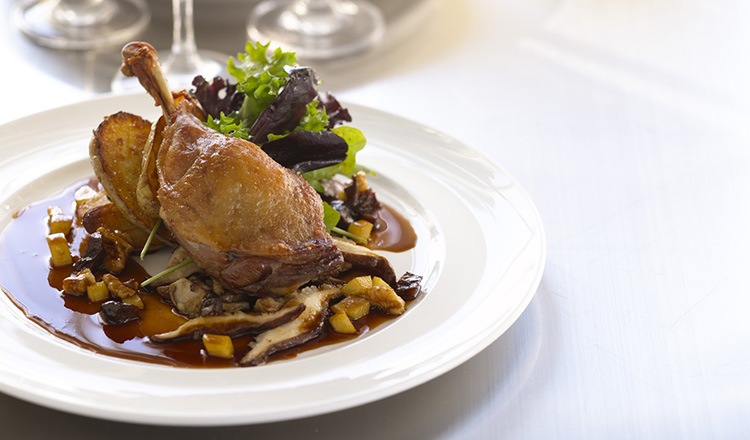Makes 4 servings
The traditional confit cooking method for duck is a method of preservation. The duck is cured, cooked very slowly in its own fat, and then stored, covered with that fat. It can be stored in the refrigerator for 4 months, so prepare more than you need. Keeping duck confit on hand in your refrigerator makes for a quick and easy meal. It can be served warm with crisped skin as described in this recipe, served warm or cold as a salad with greens or lentils, or used as an ingredient in another recipe, such a cassoulet.
Ingredients
- 1/4 cup kosher salt
- 1 teaspoon freshly cracked black pepper
- 2 teaspoons chopped thyme (or 1 teaspoon dried thyme)
- 2 bay leaves, crumbled
- 4 duck legs (about 3 lb), bone in, thighs and drumstick attached
- 1 qt duck fat, lard, or canola oil
Directions
- Combine the salt, pepper, thyme, and bay leaves.
- Rinse the duck legs under cold running water and pat dry with paper towels. Rub the duck with the salt mixture and place in a glass or ceramic baking dish. Cover the duck with plastic wrap and set a plate or pan on top. Place a heavy object, such as a large can of vegetables or a foil-wrapped brick, on top to press the duck while it is curing. Cure for 36 to 48 hours in the refrigerator.
- Preheat the oven to 190ºF. Rinse the duck legs under cold running water to remove the salt and spices and pat dry with paper towels. Place them into a Dutch oven, cover with the duck fat, lard, or oil, and transfer the uncovered pot to the oven. Roast until the duck legs are fork-tender, 6 to 7 hours. Be sure to carefully monitor the temperature of the fat during cooking; it should remain at 190ºF. When the duck legs are tender, remove them from the fat, and allow both the legs and the fat to cool enough to stop cooking. They can be used immediately or stored warm. To store, place the duck legs into a crock or bowl, cover completely with the cooled fat, and refrigerate for up to 4 months.
- When ready to serve, preheat the oven to 350ºF. Remove the duck legs from the fat. Add 1 to 2 tablespoons of the duck fat to an ovenproof pan and sear the skin side of the duck legs over medium-high heat until they are golden brown and crisp, about 2 minutes. Turn the legs over and place them in the oven until warmed through, about 12 minutes.


